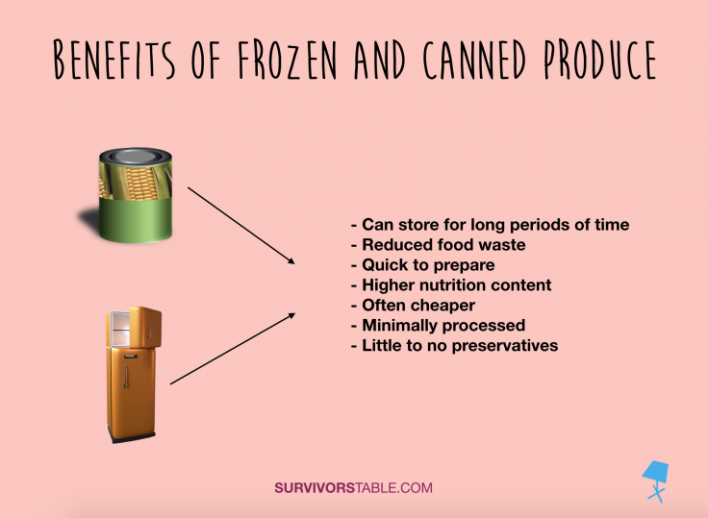Anyone with cancer or caring for someone receiving cancer treatment understands the struggle of having the time or energy to prepare food most days. Additionally cancer care is costly and this causes many of your usual staples to no longer be as affordable as they once were. A common question I’m asked is what can be prepared that is healthy, quick, and affordable. My recommendation usually is to stock up on lots of frozen and canned foods. This usually surprises people as canned or frozen produce has been given a bad rap these days. But there are many benefits that may go unrecognized. Both can reduce food spoilage due to longer shelf life, be convenient, can help increase nutrition, and can be cheaper. Additionally, frozen and canned produce are usually picked within hours of harvest and the vitamins and minerals are preserved until they are eaten. Research shows that canned and frozen foods provide as much or more nutrients as fresh one’s do. Typically fresh produce can take up to 3 weeks to transport from farm to the supermarket and slowly loses nutrients in the process. That’s not to say fresh produce isn’t a great option too, but it may not necessarily always be the best.
Another added bonus is both canned and frozen produce can be prepared within minutes. Both can serve as ingredients in soups, stews, casseroles, as a side, or can be used in some deserts. With half of all fresh produce thrown away in the US, frozen and canned produce can aid in reducing waste. What’s more, peels, cores, and other inedible parts of produce can be removed during the canning and frozen process and are then reused as compost or as food for farm animals. These production methods result in very little food wasted. So it’s a win-win!

A common misconception is that both frozen and canned produce are highly processed, but they are rather very minimally processed. Most canned and frozen produce items are preservative free as there is usually no need for preservatives to prevent spoilage since the foods are already cooked and/or sealed. With canned foods there are also low or no sugar and salt options available too. If there is more added salt and sugar than you would like, then draining and rinsing helps reduce the content. If you’re not sure, then you can always double check by reading the food label nutrition facts or ingredients. Look at the serving size listed versus how much you plan to eat to get the full picture of the nutrient content. Finally, if this information wasn’t already exciting enough, the freezing and canning process does not destroy the nutrients—instead it preserves the nutrients.
There have been some concerns by people regarding the BPA in canned goods, as it is commonly used as a protective lining. Currently the FDA deems it safe at current levels used in the food supply. However, if this is still a concern of yours then you can certainly look for BPA-free can options or just stick with frozen produce instead.
My favorite benefit to these production methods is that these items don’t require chopping, peeling, or washing produce, which saves you time. Also, people who incorporate them into their diets may even have a better diet quality since they are eating more produce. You can also help save space in your kitchen by storing canned goods in the pantry or a closet. A final tip, make sure to practice food safety by following the cooking instructions on the packages. The safest way to thaw frozen foods is in the fridge or in the microwave. If you are prepping for treatment yourself or buying for a loved one, try purchasing a few of these items ahead of time (or even last minute) and see if this helps increase nutrition and satisfaction during meal time with minimal fuss. Grocery shopping and meal preparation may become easier and cheaper now!
This post originally appeared on Survivors’ Table. It is republished with permission.








Comments
Comments